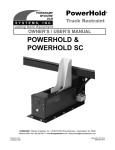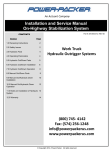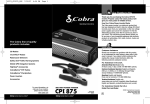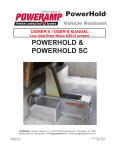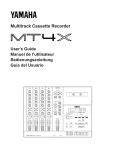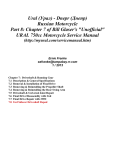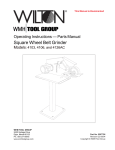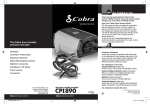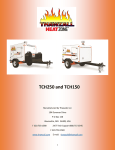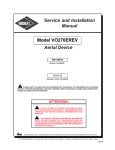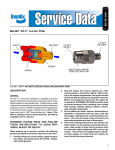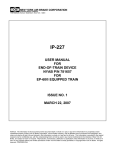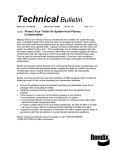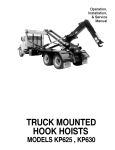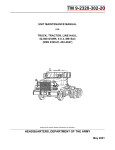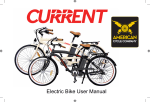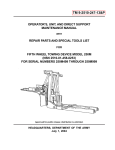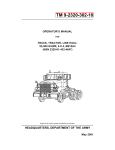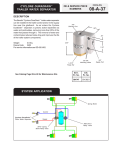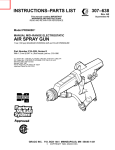Download Installation and Service Manual Air Powered - Power
Transcript
An Actuant Company Installation and Service Manual Air Powered Hydraulic Landing Gear CONTENTS 1.0 Receiving Instructions 2 2.0 Safety Issues 2 3.0 Hydraulic Fluid and Grease 3 4.0 Front Mount installation 4 5.0 Rear Mount Installation 8 6.0 Control Box 11 7.0 Master Valve 13 8.0 Booster Valve 14 9.0 Leveling Valve 15 10.0 Booster Pump Valve 16 11.0 Check Valve 17 12.0 Check Valve Repair 18 13.0 Leg Assembly 20 14.0 Leg Assembly Repair 21 15.0 Stiff Leg 22 16.0 Checking Oil 23 17.0 Preventive Maintenance 24 18.0 Replacement Shoes 26 19.0 Mounting Accessories 27 20.0 Controls and Leg Assembly 28 21.0 System Operation 29 22.0 Auto Booster Control Box 34 23.0 Auto Booster Master Valve 36 24.0 Auto Booster Assembly 37 25.0 Auto Booster Sub-Assembly 38 26.0 Power Valve Assembly 39 27.0 System Operation 40 28.0 Auto Booster Schematic 42 29.0 Troubleshooting 43 30.0 Auto Booster Troubleshooting44 31.0 Warranty 46 Part # 81-1304, REV 0C Power-Packer 516 Hillcrest Drive Westfield, WI 53964 PHONE: (800) 745- 4142 FAX: (574) 256-1248 EMAIL: [email protected] www.powerpackerus.com © Copyright 2015, Power-Packer. All rights reserved. Issued: April 2015 81-1304 REV 0C Installation and Service Manual Air Powered Hydraulic Landing Gear 1.0 Important Receiving Instructions Visually inspect all components for shipping damage prior to installation. Shipping damage is not covered by warranty. If shipping damage is found, notify carrier at once. The carrier is responsible for all repair and replacement costs resulting in damage from shipment. For most current manual, see http://www.powerpackerus.com Product descriptions and specifications are subject to change. For specific versions related to your product, contact us. 2.0 Safety Issues Read all instructions, warnings and cautions carefully. Follow all safety precautions to avoid personal injury or property damage during system operation. Power-Packer cannot be responsible for damage or injury resulting from unsafe product use, lack of maintenance or incorrect product and/or system operation. Do not remove warning labels, tags or decals. Contact Power-Packer when in doubt as to the safety precautions and operations. This manual follows a system of safety alert symbols, signal words and safety messages to warn the user of specific hazards. Failure to comply with these warnings could result in serious personal injury or death, as well as damage to equipment or other property. This is a Safety Alert Symbol that appears throughout this manual. It is used to alert you to potential physical injury hazards. Pay close attention to Safety Alert Symbols and obey all safety messages that follow this symbol to avoid possible serious personal injury or death. WARNING CAUTION NOTE Safety Alert Symbols are used in conjunction with certain Signal Words that call attention to safety messages or property damage messages and designate a degree or level of hazard seriousness. The Signal Words used in this manual are WARNING, CAUTION, and NOTICE. WARNING indicates a hazardous situation that, if not avoided, could result in death or serious injury. CAUTION indicates a hazardous situation that, if not avoided, could result in minor or moderate injury. NOTE indicates information considered important, but not hazardrelated (e.g. messages related to property damage.) 2 81-1304 REV 0C NOTENOTE Our experience indicates that mixtures of oil and fuel oil cause seals to swell, resulting in subsequent sticking or sluggish action on the landing legs. Installation and Service Manual Air Powered Hydraulic Landing Gear 3.0 Hydraulic Fluid and Grease Specifications Power-Packer recommends using a quality ISO 15 anti-wear hydraulic fluid for most applications. If operating in cold temperatures slower operation will occur. If slower operation in cold weather affects your operations, we recommend using a fluid specially-formulated for cold temperatures. We have found that ISO 15 anti-wear hydraulic fluids work well with Power-Packer systems to -20° F. If consistently operating at temperatures below -20°F, then we recommend hydraulic fluids conforming to MIL-PRF-5606H or MIL-H5606A (obsolete). If you have any questions regarding fluid recommendations, please call us. NOTE Always grease leg in the fully retracted position. DANGER Do not place any body parts (feet) below leg shoe while in operation. The operator must be fully aware of people’s position in the trailer area. 3 81-1304 REV 0C CAUTION Do not weld on truck frame. Installation and Service Manual Air Powered Hydraulic Landing Gear 4.0 Front Mount Installation Step 1Remove manually-operated landing gear (if applicable). Step 2- Leg Mounting Install landing gear legs to standard landing gear mounting brace. Allow 12" ground clearance with legs fully retracted. Use 5/8"- 18 UNF grade 5 hex head cap screws and hex nuts. Torque to 100 ft-lbs. Step 3 - Bracing Brace leg as shown. Any bracing system must brace the bottom of the landing gear leg to structural members of the trailer in two directions 90° apart. Make sure bracing will not interfere with tractor. Use proper size (5/8") or bigger, grade 5 or better. NOTE Split collar to be located flush with bottom of well tube. Locate grease fitting in slot. NOTE Install spacers between slit collars (4). Do not weld bracing and/or ears directly to well tube. Weld to split collar only. Do not weld split collar to leg. Install spacers between split collars. Do not use split collar bolts to attach bracing. Split collar bolts should be torqued to 20 ft-lbs. Do not weld on collar while on leg. Step 4 - Control Box Mounting Determine desired control box location. No part of control box or handles should extend beyond the sides of the trailer. A 10- and 12-foot high pressure hose, and 25 feet of low-pressure tubing are supplied as standard. If other lengths are needed, please call Power-Packer. Hold control box in desired location. Be sure trailer cross members are free of rust and undercoating where control box hanger straps make contact. Tack weld hanger straps in place. Remove hanger strap bolts and lower control box. Finish welding hanger straps to trailer cross members and remount control box. Torque mounting bolts to 20 ft-lbs. Step 5 - Plumbing Cut emergency brake line and insert tee and 75 PSI pressure protection valve (part number 86640 PPV Kit). Pressurized air is required to positively hold the legs up when the travel is traveling, and to operate the legs when the trailer is parked. Then usual source of air is the tractor’s compressor via the air supply line. Figure 1 (page 7) is a circuit with a third gladhand that meets the above requirements. To operate landing gear, the operator moves the tractor’s supply gladhand from the trailer’s supply line connection to the 3rd gladhand (4). This sets the trailer’s parking brakes and connects tractor air to landing gear’s control box. The pressure protection valve’s integral check valve prevents loss of air. 4 81-1304 REV 0C CAUTION Installation and Service Manual Air Powered Hydraulic Landing Gear 4.0 Front Mount Installation cont. Do not weld on truck frame. Step 2 Cross Brace Rear of Trailer Grease fitting in split collar slot Step 4 5 81-1304 REV 0C Installation and Service Manual Air Powered Hydraulic Landing Gear 4.0 Front Mount Installation cont. NOTE The parking brakes of the tractor and/or trailer will not function with this circuit because the supply line is not vented when landing gear functions. An alternative method of applying the parking brakes should be provided. The 3rd gladhand circuit does not cause the parking brakes to be inoperative when the landing gear is operating. NOTE Figure 1 Item Descriptions: 1) Tee connector 3/8 NPT 2) Pressure protection valve 3/8 NPT 50-55 PSI and integral check valve 3) Check valve soft seal In final preparation to move the trailer, the operator returns the tractor's supply gladhand to the trailer's supply line connection. This returns the truck's air system to normal while providing air via the tee (1) and pressure protection valve (2) to positively hold the legs up. Check valve (3) prevents loss of air through the 3rd gladhand. Figure 2 (page 7) is a circuit showing a hook-up without addition of the 3rd gladhand. While the needs of landing gear are satisfied, the trailer's parking brakes will not be set until landing gear's operation is complete and the supply line is vented. If this type of hook-up is desired, an alternate method of applying the parking brakes while landing gear is operational should be provided. Connect 1/2" 0.0. nylon tubing from the bottom port of each leg to a union tee midway between each leg. Connect 1 /2" 0.D. nylon tubing from third connection of tee t o bottom port of retract oil! tank (step 4). Check to insure shunt valves are installed per item 14 on page 5. Connect 3/8" H.P. hose from top port of right (curb) side leg to HYD. R.H. leg port to manifold. Connect 3/8" H. P. hose from top port of leg (road) side leg to HYD. L.H. leg port on manifold. Step 6 - Filling Connect air to trailer (50 PSI maximum) and move master valve handle to "up travel." When legs are fully retracted and air is no longer heard moving, remove fill cap from main oil tank extend fill tube. Fill main oil tank extend with 11 quarts of fluid. (See page 3 for fluid recommendations.) Replace fill cap. Extend legs to ground. (Refer to front decal for operating instructions.) Fully retract legs. This procedure bleeds air from the extend side of the leg. 4) Gladhand NOTE Figure 2 Item Descriptions: 1) Tee connector 3/8 NPT Extend legs to ground and cycle booster valve until legs are fully extended. Keep master valve in ”down park” position. When air is no longer heard moving, remove retract oil tank fill plug. Fill retract oil tank with 6 quarts of fluid. Replace fill plug. Fully retract legs. Additional operation by fully extending and retracting the legs may be required to bleed all air form the system (2 cycles minimum). Check all fittings and hoses for leaks. Secure hoses in a manner that will not cause chafing. Your system is now ready for use. 2) Pressure protection valve 3/8 NPT 50-55 PSI and integral check valve 6 81-1304 REV 0C Installation and Service Manual Air Powered Hydraulic Landing Gear 4.0 Front Mount Installation cont. Main oil tank (extend), 11 quarts Retract oil tank 6 quarts Fluid level port Fluid fill cap Step 4 Step 5 Figure 2 Air Pressure Hook-Up Two Gladhands 7 Figure 1 Air Pressure Hook-Up 3rd Gladhand 81-1304 REV 0C Installation and Service Manual Air Powered Hydraulic Landing Gear 5.0 Rear Mount Installation Step 1 Determine location for landing gear legs. Normally, legs will be mounted between the rear tires. You should allow 6 inches of ground clearance (4 inches absolute minimum). Remember to allow for spring deflection when trailer is loaded. Step 2 - Leg Mounting This is one common way of mounting "rear mount" landing gear. Other methods may be used. When designing a mounting structure, provide enough strength to lift the trailer and proper bracing to take any side loading. Remove wheels, if necessary. Cut a 6-inch channel to desired length (varies with trailer frame and leg stroke). Weld a 12-inch long piece of 3/16" steel plate to the inside of the channel. These plates should be wide enough to place the center of the leg between the tires when the leg is mounted to the channel. Weld a loose mounting plate (order from Power-Packer) to the channel at the proper height (per installation requirements). Weld a split collar half to the mounting channel where the bottom of the well tube will be located. Weld this fabrication to the trailer frame. Fabricate second leg mounting structure in the same manner. Mount legs using 5/8"-18 UNF grade 5 bolts. Torque to 100 ft-lbs. Clamp remaining split collar halves in place with 1/2"-20 UNF grade 5 bolts. Torque to 20 ft-lbs. Step 3 - Bracing Other bracing systems may be used to suit the application. The bottom of each leg must be braced to the trailer frame members in two directions 90° apart. These braces should not be welded to the leg. They may be mounted to the split collar, channel, and/ or the cross brace near the leg. See page 5, steps 2 and 3 for clearer view of split collars. Weld cross brace from bottom of one channel to the other. Weld a brace from the bottom of each channel to the trailer frame at 45° angle. This brace should be pointed directly away from the leg. On each side, weld bracing pointed straight forward and/or back ward at a 45° angle from each channel on the cross brace to the trailer frame. Step 4 - Control Box Mounting Please see Steps 4, 5 and 6 starting on Page 7 for control box mounting, plumbing and filling. 8 81-1304 REV 0C Installation and Service Manual Air Powered Hydraulic Landing Gear 5.0 Rear Mount Installation cont. Step 2 3/16” Thick steel plate 12” Landing gear mounting plate 6” channel 9”x12” plate to channel Flush with bottom of well tube Weld 1/2 split collar to channel Weld Trailer frame Weld Secure to mounting bracket with bolts Fixed foot 9 81-1304 REV 0C Installation and Service Manual Air Powered Hydraulic Landing Gear 5.0 Rear Mount Installation cont. Step 2 3/16” Thick steel plate Step 3 Step 4 Pressure protection valve To bottom port left leg Retract oil tank Main oil tank (extend) 10 High pressure High pressure hose to L.H. hose to R.H. leg top port leg top port Fluid fill cap for main oil tank (extend) 81-1304 REV 0C Installation and Service Manual Air Powered Hydraulic Landing Gear 6.0 Control Box Drawing 11 81-1304 REV 0C Installation and Service Manual Air Powered Hydraulic Landing Gear 6.0 Control Box Parts List Item 1-18 Part Number Description Qty 100104 100106 Control box - standard 1 Control box - high pressure 1 1 100316 Base channel 2 2 100322 Hanger strap 2 3 100317 Base plate 1 4 100120 Leveling valve 1 5 100117 Master valve 1 6 100122 Booster valve 1 7 100327 Handle 3 7A 18-1002 Roll Pin 3 100124 Booster pump-standard 1 100126 Booster pump-high pressure Steel line (master valve to leveling valve) Steel line (manifold to leveling valve) right leg Steel line (manifold to leveling valve) left leg Steel line (master valve to booster pump) Manifold 1 8 9 100320 10 100191 11 100190 12 100318 13 100129 14 Shunt valve* 1 1 1 1 1 2 as req'd 15 001-Bulk Nylon tubing (typ) 16 100128 Main oil tank (extend) 1 17 100127 Retract oil tank 1 18 100321 Cover 1 19 100326 Decal For control box part no. 100104 use 1004-043 shunt valve For control box part no. 100106 use 1004-038 shunt valve 1 * 12 81-1304 REV 0C Installation and Service Manual Air Powered Hydraulic Landing Gear 7.0 Master Valve Part List & Drawing Item 1 Part Number 2 * 100135 3 07-1024 4 07-1012 5 100329 Description Qty Wiper 1 Oil Return Block 1 Branch T (3/8 npt x 08.37° flare) 90° elbow (3/8 npt x ½ comp.) 1 1 2 3 6 15-1004 Mounting bracket Hex head cap screw (3/8-16x3/4 lg) 7 16-1002 Lock Washer (3/8) 2 8 100134 Front adapter plate 1 9 15-1002 2 10 11 * 100328 Socket head cap screw (1/4-28 x 5/8 lg.) O-ring (3/4 i.d. x 1/8 c.s Valve spool 1 12 18-1002 Roll pin (5/32 dia. x 1" lg.) 1 13 15-1001 Roll pin (5/32 dia. x 1" lg.) 4 1 2 14 100133 15 15-1003 Rear adapter plate Hex head cap screw (1/4-20 x 3/4 lg.) 2 16 16-1001 Lock washer (1/4) 2 17 O-ring (7/16 i.d. x 3/32 c.s.) 1 18 * 09-1002 Air valve 1 19 07-1017 07-1016 Connector (3/8 npt x 1/2 comp.) 45° elbow (3/8 npt x 1/2 comp.) 1 20 21 10-1002 Grease fitting 2 22 * 18-1004 Gasket Roll pin (1/4 dia x 1 ½” lg.) 1 23 24 18-1011 Roll pin (1/4 dia x 1” lg.) 2 25 001-Bulk Vent tube 1 * Contained in valve repair kit 100224 13 1 1 Part Nos. 100117 100313 81-1304 REV 0C Installation and Service Manual Air Powered Hydraulic Landing Gear 8.0 Booster Valve Part List & Drawing NOTE Valve is not repairable. Purchase a complete valve assembly. Part Nos. 100122 100314 Item Part Number Description Qty 1 100332 Handle adapter 1 2 18-1001 Roll pin (5/32 dia. x 3/4 lg.) 1 3 15-1034 Machine screw (#10-24 x 3/8 lg.) 4 4 100331 Mounting bracket 1 5 09-1001 Air valve 1 6 07-1001 Pipe plug (3/8 npt) 1 7 07-1016 45° elbow (3/8 npt x 1/2 comp.) 1 8 07-1012 90° elbow (3/8 npt x 1/2 comp.) 1 14 81-1304 REV 0C Installation and Service Manual Air Powered Hydraulic Landing Gear 9.0 Leveling Valve Part List & Drawing Part No. 100120 Item Part Number Description Qty 1 15-1014 Socket head cap screw (5/16-18 x 1/21g.) 3 2 100188 Mounting bracket 1 3 15-1004 Hex head cap screw (3/8-16 x 3/41g.) 2 4 07-1010 90° elbow (3/8 npt x 08 37° flare) 2 5 07-1025 90° elbow (3/8 npt x 08 37° flare) 1 6 100298 Valve body 1 7 10-1002 Grease fitting 2 8 18-1003 Roll pin (3/16 dia. x 1" lg.) 2 9 * O-ring (3/4 i.d. x 1/8 c.s.) 10 100336 Valve spool 11 100301 Return spring 12 100300 Spring Collar 13 18-1004 Roll pin {1/4 dia. x 1-1/2 lg.) * Contained in valve repair kit 100224 15 4 1 1 1 1 81-1304 REV 0C Installation and Service Manual Air Powered Hydraulic Landing Gear 10.0 Booster Pump Valve Part List & Drawing Part No. 100124 Standard 100126 High Pressure Item Part Number Description Qty 1 07-1011 45° elbow (3/8 npt x 1/2 flareless) 1 2 19-1001 Steel ball (1/2 dia., grade 100) 2 3 100171 Booster output port 1 100166 Std. booster nozzle 1 4 100183 High pressure booster nozzle 1 5 15-1005 Hex nut (5/16-24) 8 6 16-1003 Lock washer (5/16) 8 7 100170 Tie rod 4 8 9 10 11 12 * O-ring standard (1" i.d. x 1/8 c.s.) 1 * O-ring- high pressure (7/8" i.d. x 1/8 c.s.) 1 * Back-up washer- standard (1" i.d. x 1/8 c.s.) 1 * Back-up washer- high pressure (7/8" i.d. x 1/8 c.s.) 1 100160 Standard stop tube 1 100182 High pressure stop tube 1 100165 Booster tube 1 100161 Standard piston rod assembly (1" rod) 1 100180 High pressure piston rod assembly (7/8" rod) 1 13 * High pressure piston rod assembly (7/8" rod) 1 14 * Back-up washer (5" i.d. x 3/16 c.s.) 1 15 100159 Blind end cap 1 16 07-1012 90° elbow (3/8 npt x 1/2 comp.) 1 * Contained in repair kit 100408 16 81-1304 REV 0C Installation and Service Manual Air Powered Hydraulic Landing Gear 11.0 Check Valve Part List & Drawing Part No. 100540 Item Part Number Description Qty Check valve assembly 1 1 100540 100534 Check valve body 1 2 100209 Check valve cap 1 3 100208 Piston spring 1 4 15-1011 Hex head cap screw 6 5 100535 Check valve piston 1 6 * O-ring 1 7 * O-ring 1 8 * Quad ring 1 1-15 9 * Steel ball 1 10 * O-ring 1 11 * Check insert 1 12 * Spring 1 13 100531 Check body insert 1 14 100533 Check insert top 1 15 * O-ring 1 These items contained in check valve repair kit 100221 1 * (8) (1) (15) 17 (1) (3) (7) (5) 81-1304 REV 0C NOTCAUTION Use eye protection. Installation and Service Manual Air Powered Hydraulic Landing Gear 12.0 Check Valve Repair Procedure Use Repair Kit Part No. 100221 The item numbers listed below are the same as those listed on the check valve assembly drawing, page 17. IMPORTANT: CAUTION Check valve cap and check valve piston are spring loaded. 1. Inspect all parts for scratches, nicks and other defects, replace if necessary. 2. All new seals and parts should be lightly coated with grease (grade 0 or 00) before reassembling. 3. Remove rust and other debris using a very fine steel wool if required. Do not use emery cloth because it leaves scratches in metal parts that causes excessive wear on o-ring and parts. 4. Remove check valve assembly, Part No. 100540 from leg by using strap wrench in a ccw manner. To do this without removing leg from trailer requires a 2" clearance above the check valve. Make sure all pressure is relieved before check valve is removed. 5. Thoroughly clean all hard parts before assembly. DISASSEMBLY: A. To remove check valve from leg, make sure no weight is being supported by legs. Have legs slightly extended from full retract position to relieve any internal pressure in legs. Disconnect the hoses from the leg. You may wish to mark which hose goes to what port. Unscrew the check valve from the leg using counter clockwise rotation. B. Remove the six H.H.C.S., Item 4 and check valve cap, Item 2. Normally check valve piston, Item 5 and piston ring, Item 3 will release at this point. Remove o-rings, Items 6, 7,and 8. If check valve piston, Item 5 and piston spring, Item 3, do not release, proceed with C and D below and perform E below. CAUTION Check valve parts are spring loaded. C. Turn check valve body, Item 1, upside down. Check insert body, Item 13 is installed and held in by an interference fit. To remove slide a 5/8” deep socket onto check insert body, Item 13 and using a socket cheater bar in rigid position, work back and forth until check insert body is released. D. Remove o-ring, Item 15 and check insert top, item 14. Remove steel ball, Item 9, o-ring Item 10, check insert, Item 11 and spring, Item 12 form check insert body, item 13. E. If check valve piston, Item 5 has not released, lay check valve body, Item 1, on side and insert brass or aluminum drift punch form bottom side of check valve body and tap with light hammer. 18 81-1304 REV 0C NOTCAUTION Installation and Service Manual Air Powered Hydraulic Landing Gear 12.0 Check Valve Repair Procedure cont. ASSEMBLY: Use eye protection. 1. Place insert check top, Item 14 into counter bore flat side down. Place o-ring, Item 15 into shallow counter bore. CAUTION Check valve cap and check valve piston are spring loaded. 2. Assemble check insert body, Item 13 by placing check insert, Item 11, in seat flat side down into check insert body, Item 13. Insert spring, Item 12, insert steel ball, Item 9, insert Teflon oring, Item 10 and press firmly into place. 3. Place check insert body, Item 13, into check valve body, Item 1, counter bore and use a large punch and light hammer to drive the check insert body, Item 13, into place. Interference fit. 4. Turn check valve assembly, 100540, right side up. Install quad ring, Item 8. Install o-ring, Item 6 on check valve piston, Item 5. Install piston spring, Item 3 on check valve piston, Item 5 and insert in piston cavity where Item 5 is located. Install o-ring, Item 7 in groove. Place check valve cap, Item 2 over check valve piston, Item 5 and compress to install H.H.C.S., Item 4 and torque to 9 ft.-lbs. 5. Reinstall on leg making sure that o-ring and backup washer are on piston rod and tighten check valve assembly, 100540 with strap wrench. The check valve may have to be rotated to connect the hoses. To do this, remove H.H.C.S., Item 8 (see leg assembly drawing page 20) and rotate check valve, clockwise only, so ports are accessible then reinstall H.H.C.S., Item 8. Connect hoses and cycle legs several items to bleed air from system, then check the oil level. 19 81-1304 REV 0C Installation and Service Manual Air Powered Hydraulic Landing Gear 13.0 Leg Assembly Part List & Drawing Item 1 Part Part Number Number 3.5" Bore 4.0" Bore 100540 100540 Description Notes Check valve assembly Qty 1 2 O-ring 1, 2 1 3 Back-up washer 1, 2 2 4 O-ring 1, 2 1 5 Back- up washer 1, 2 1 6 Snap ring, 2" rod 2 1 7 O-ring 2 1 8 15-1004 15-1021 Hex head cap screw 1 9 16-1002 16-1002 3/8" lock washer 4 10 15-1012 15-1012 Hex head cap screw 1 11 100278 100279 Cylinder head retainer 1 12 Retaining ring 2 1 13 Oil seal 2 1 1 14 Rod seal 2 15 O-ring 2 1 16 Back-up washer 2 1 17 100216 100276 Cylinder head 1 18 * * Piston rod 1 19 * * Well tube 20 21 Wear ring 10-1001 10-1001 1 2 2 Grease fitting 1 22 Piston seal 2 1 23 O-ring/square seal 2 1 24 Back-up washer 2 2 25 Wear ring 2 1 Snap ring, 1.75 rod 1 27 100217 * Piston 1 28 * * Cylinder tube 26 29 1 Nylon ball 2 1 30 Set screw 2 1 31 Split collar assembly (not shown) 100346 * 100348 1 State the part number and part description when ordering. Notes: 1. These items are contained in check valve repair kit part no. 100221 and are not available on an individual basis. 2. These items are contained in leg repair kit part no. 101086 (3.5” bore) or part no. 100422 (4.0” bore) and are not available on an individual basis. 20 81-1304 REV 0C NOTE When disassembling and reassembling the leg, care should be taken to keep all parts clean and to prevent parts from being damaged. CAUTION While lifting piston rod, oil will squirt out of side port at top of rod. NOTE All seals should be coated lightly with grease before installation into leg. Installation and Service Manual Air Powered Hydraulic Landing Gear 14.0 Leg Assembly Repair Procedure 3.5” Bore Leg Repair Kit Part No. 101086 4.0” Bore Leg Repair Kit Part No. 100422 DISASSEMBLY/ASSEMBLY The item numbers listed below are the same as those listed on the leg assembly drawing. 1. To remove leg from trailer, make sure no weight is being supported by legs. Have legs slightly extended from full retract position to relieve any internal pressure in legs. Disconnect the hoses from the leg. You may wish to mark which hose goes to what port. Remove the leg from the trailer. 2. Remove the lock valve, Item 1 from the leg by screwing counter clockwise. (If you need only to repair the lock valve, it may be removed from leg while still on trailer if you have a minimum of 2" clearance above.) 3. Remove o-rings and back-up washers, Items 2, 3, 4 and 5. Using a snap ring pliers, remove snap ring, Item 6. Loosen hex screw, Item 8. 4. Lift well tube, Item 19 off lower leg assembly. Lift piston rod, Item 18 to gain access to top of cylinder head, Item 17. 5. Remove 4 hex screws, Item 10. Lift cylinder head retainer, Item 11. A wire or rubber band maybe used to hold Item 11 to sprocket near the top of the piston rod (out of the way). 6. Using a flat screwdriver, carefully remove spiral retaining ring, Item 12. Lift rod piston assembly out of cylinder tube, item 28. 7. Using a large snap ring pliers, remove heavy duty snap ring Item 26 or remove the set screw, Item 30. Remove the piston, Item 27, cylinder head, Item 17, retaining ring, Item 12 and cylinder head retainer, Item 11. 8. Remove all seals and wear rings. Clean all parts. Inspect all bearing surfaces tor scratches, nicks or other defects; replace if necessary. Replace all wear rings and lightly lubricate all seals before installing on legs. 9. Carefully reassemble the leg in reverse order as described above. Where applicable, torque piston, Item 27 to 40-50 ft-lbs. Apply 2 drops of Loctite 277 or equivalent to set screw, Item 30 and torque to 50 in./lbs. 10. Return leg to trailer and reconnect all hoses. Apply grease to grease fittings, Item 21 and cycle legs fully several times to bleed air from the system. Check oil level as described in maintenance section of manual. 21 81-1304 REV 0C Installation and Service Manual Air Powered Hydraulic Landing Gear 15.0 Stiff Legs Part List NOTE When ordering parts for a stiff leg model, all parts are common with a non-stiff leg model (see page 20), except for the parts below. NOTE Items 3, 4, 5 can be purchased in Hitch pin kit part no. 101504. Item 1 Part Number Description Qty 1 2 * * Well tube Stiff leg 1 3 18-1019 Cotterless hitch pin 1 4 99-1002 Ferrule 2 5 15-1052 Screw 1 6 087-009000 Cable 1 * State the part number when ordering. 22 81-1304 REV 0C Installation and Service Manual Air Powered Hydraulic Landing Gear 16.0 Checking Oil NOTE Correct oil levels in both tanks on landing gear is very important. CHECKING OIL LEVELS Procedure for checking and filling both oil tanks: 1. Main Oil Tank. Tank is located behind controls on control box. Fill tube to left side of control box. a. Move master valve handle to "up travel" right. b. When legs are fully retracted and air is no longer heard moving, remove fill tube cap. c. Fill main oil tank until additional oil will not be accepted. d. When legs are fully retracted and air is no longer heard moving, remove fill tube cap. e. Fill main oil tank until additional oil will not be accepted 2. Retract Oil Tank. Tank is located to left of control box. a. Move master valve to "down park" left and extend both legs to ground. Cycle booster valve (right side of control box) manually or hold auto booster button in (on auto booster system) until both legs are fully extended. b. When air is no longer heard moving, remove retract oil side tank fill plug and fill until additional oil will not be accepted. Replace fill plug. c. Move master valve to "up travel" and fully retract both legs. d. Cycle system 2 complete cycles to insure all air is removed from system. CAUTION Check valve parts are spring loaded. 23 81-1304 REV 0C Installation and Service Manual Air Powered Hydraulic Landing Gear 17.0 Preventive Maintenance NOTE In order to obtain continued high performance from your landing gear unit, we recommend following the yearly service procedure. NOTE NLGI grade "00" or "0" lithium grease, use hand grease gun only. In order to obtain continued high performance from your landing gear unit, we recommend the following yearly service procedure: 1. Change Oil a. With legs fully extended and master valve in "down park," drain retract oil tank by removing nylon line at bottom of tank or plug if equipped. Reconnect and refill with 6 quarts of approved fluid to fill port level. b. Connect air supply to system and fully retract legs (leave handle in "up travel"). c. Disconnect air supply from system. d. Disconnect top hydraulic line at each leg and put ends into container to catch oil. e. Connect air supply to system. f. Very slowly, move master valve handle toward "down park" position until oil starts coming out of lines. Leave in this position until all oil has been exhausted from main tank. g. Move master valve handle to "up travel" position and reconnect lines to leg. h. Remove filler cap from end of fill pipe of main oil tank and fill with 11 quarts of approved fluid. i. Operate landing gear for at least two full cycles (complete leg strokes) to bleed air from system. 2. Check all hydraulic lines and fittings for leaks spots. Replace any defective lines and fittings. and worn 3. Check tor loose bolts and nuts. LUBRICATION OF LANDING GEAR SYSTEMS In order to provide continued performance of your landing gear system, the following lubrication procedures are required at approximately six month intervals: Spray WD-40 or equivalent into booster pump vent hole. Inject anti-seize to all 4 grease fittings (LOCTITE or "FELPRO" CS-A). If unavailable, use NLGI grade "00" or "0" lithium grease. 24 81-1304 REV 0C Installation and Service Manual Air Powered Hydraulic Landing Gear 17.0 Preventive Maintenance cont. NOTE In order to obtain continued high performance from your landing gear unit, we recommend following the yearly service procedure. LUBRICATION OF LANDING GEAR SYSTEMS cont. Inject grease into vent hole (on front of new soft seat check valve) (Figure 1) and on the rear of older hard seat check valve (Figure 2) using a rubber tip adapter ("Lubrimatic" code 11860). Check valves produced after July 1987 have a grease fitting without a ball. When all lubrication is completed, extend and retract legs full stroke. Excess grease will be pushed out of leg check valve vent. Figure 1 NOTE Inject grease into vent hole or grease fitting (use hand grease gun only). Fully extend leg and wipe old grease off cylinder tube. Retract leg and as leg is retracting apply grease to grease fittings at bottom of well tube. Inject grease after cleaning cylinder tube. See note (power grease guns may be used at this point). Figure 2 Inject grease into vent hole or grease fitting (use hand grease gun only). 25 81-1304 REV 0C Installation and Service Manual Air Powered Hydraulic Landing Gear 18.0 Replacement Shoes Part No. 100411 For the convenience of Power-Packer customers, the replacement foot, or shoe, has been redesigned to facilitate an easier repair and replacement of damaged or worn feet. The new design should make changing feet simpler and less time-consuming. The following steps illustrate the procedure. 1. Replacement Foot part number 100411. 2. Retract leg. 3. Remove damaged foot. Be sure not to cut into end cap of cylinder. There are two notches 180° apart on the end cap on the cylinder tube. Use these notches to start your cut. 4. Place shoe halves under leg. 5. Lower leg to shoe halves, shoe will self center, weld across the top. 6. Retract leg and weld across the bottom. 1. Replacement Foot part number 100411 4. Place shoe halves under leg. 26 2. Retract leg. 5. Lower leg to shoe halves, shoe will self center, weld across the top. 3. Remove damaged foot. Be sure not to cut into end cap of cylinder 6. Retract leg and weld across the bottom. 81-1304 REV 0C Installation and Service Manual Air Powered Hydraulic Landing Gear 19.0 Mounting Accessories Part No. 100354 Curved ear Part No. 100357 Straight ear Part No. 100353 Angle ear Part No. 100346 Split collar assembly (100 series) Part No. 100348 Split collar assembly (400 series) Part No. 100226 Mounting plate 9 x 16 x 3/8, 14 holes (400 series) Part No. 100509 Mounting plate 9 x 10-5/8 x 1/4, 10 holes (100 series) Part No. 100502 Mounting plate 9 x 8-3/8 x 1/4, 8 holes (100 series) Note: All holes 11/16” dia. On 7-1/2” x 2-1/4” centers 27 81-1304 REV 0C Installation and Service Manual Air Powered Hydraulic Landing Gear 20.0 Identification - Controls & Leg Assembly NOTE Before calling the factory to order parts for your landing gear unit, please try to identify the series of control box and the model leg you have. If you have any doubts, contact the factory for assistance. Series Control Box Power Gear I Manufactured 1/1965 – 3/1980 DISCONTINUED PARTS NOT AVAILABLE Power Gear II Manufactured 3/1980 – 8/1980 Distinguishing Characteristics 1. 2. 3. 4. 1. 2. 3. 4. Landing Gear (Power Gear III) Manufactured 8/1980 – present NOTE On some older model legs, the model number is not always located on the leg. Call the factory with the following three dimensions and we will determine what model leg you have: 1. 2. 3. Yellow decal. May/may not have air side tank. Fill tube comes through box. Master valve handle located in center of box. White decal. Larger box. Master valve located in upper left corner of box. Please contact factory. Yellow decal. Fill tube between box and tank. Master valve Handle located in center of box. Parts are available for all units, either direct replacement or a retrofit. Check parts manual for part numbers or consult factory for details at (800) 745-4142. LEGS The model number for the legs is located on the well tube (outermost tube) between the 9/16 hex screw and the caution decal (see diagram). 1. Mounting height 2. Length of well tube 3. Circumference of well tube 28 81-1304 REV 0C Installation and Service Manual Air Powered Hydraulic Landing Gear 21.0 System Operation – Standard CONTROL BOX HYDRAULIC CIRCUIT OPERATION . The Landing Gear Control Box is an air powered hydraulic power supply designed to operate two Landing Gear Legs. The Control Box will supply high pressure hydraulic energy to extend the legs or lift the trailer and low pressure hydraulic to retract the legs. For best results, lock engine throttle at 1000-1200 ppm. The Control Box has six (6) major components. They are: 1. Master Control Valve - The Master Control Valve has two parts, the rear or air portion and the front or oil return block. The Master Valve is used to extend or retract the legs. 2. Leveling Valve - The Leveling Valve is used to adjust for uneven ground or load conditions and slows down or stops one leg or the other. 3. Booster Valve - The Booster Valve is used to cycle the Booster Pump. 4. Booster Pump - The Booster Pump is the energy "transformer'‘ that changes low pressure air energy into high pressure hydraulic energy to extend the legs. 5. Main Oil Tank - The Main Oil Tank is used to store and pressurize the oil used to extend the legs. 6. Retract Oil Tank -The Retract Oil Tank is used to store and pressurize the oil used to retract the legs. CIRCUIT OPERATION To best explain circuit operation, first assume that both legs are at midstroke. Turning the Master Control Valve as far counter clockwise as it will go will put the Master Valve in the "legs retract" mode. In this position any air pressure in the Main Oil Tank is vented to atmosphere through the air portion of the Master Valve. Air Pressure from the emergency air brake line is connected to the Retract Oil Tank by the air portion of the Master Valve. At the Retract Tank the air pressure forces oil out to the bottom or retract port of the legs, causing the legs to retract. Oil returning from the top port or extended side of the legs comes in through the Leveling Valve. By turning the Leveling Valve handle one way or the other either leg may be partly or completely stopped. Oil flows out of the Leveling Valve and to the Booster Valve and to the Oil Return Block in the Master Valve. At the Booster Pump the oil is stopped from flowing by one of the ball checks in the Booster Nozzle but the oil can flow in the Master Valve and return to the Main Oil Tank. By moving the Mater Valve handle SLIGHTLY clockwise, it is possible o slow the legs down as they retract. When the legs are fully retracted, the air pressure in the Retract Tank will hold the legs up. The Master Valve should always be in the position for over-the-road travel. To extend the legs, rotate the Master Valve handle clockwise as far as it will go. Air pressure inside the Retract Oil Tank is vented to atmosphere through the air portion of the Master Valve. 29 81-1304 REV 0C Installation and Service Manual Air Powered Hydraulic Landing Gear 21.0 System Operation – Standard cont. CIRCUIT OPERATION cont. . Air pressure from the emergency air brake line is connected to the Booster Valve and also to the Main Oil Tank. The oil return passage in the Master Valve is blocked with the Master Valve and also to the Main Oil Tank. The oil return passage in the Master Valve is blocked with the Master Valve in the legs extended position, and oil cannot flow through it. The legs extend in two "phases." In the first phase, the legs travel rapidly to the ground. After they are firmly on the ground, the Booster Pump must be actuated to lift the load. This is phase two. In the first phase, "LEGS EXTENDED, RAPID TO GROUND," oil flows from the main Oil Tank to the Booster Nozzle. The Booster Nozzle has two ball checks. The bottom check allows oil to flow into the Booster but not out. The top ball check allows oil to flow out but not in. This combination allows oil to flow through the Booster Nozzle, to the Leveling Valve and to the legs. The Leveling Valve handle may be turned one way or the other to slow down or completely stop either leg. Oil from the "RETRACT' side of the leg returns to the Retract Oil Tank as the legs extend. Once the legs reach the ground, air pressure alone is not enough to lift the trailer. In order to lift the trailer, the Booster Valve must be cycled. This is done by rotating the Booster Valve handle, alternating to both extremes, all the way clockwise, then counter clockwise, clockwise, counterclockwise, etc. This is repeated until the trailer has been raised to the desired height. As the Booster Valve handle is rotated, this is what happens: When the handle is rotated clockwise, the blind or back end of the Booster is vented to the atmosphere. Oil, under air pressure, from the Main Tank enters the Booster Nozzle and pushes the piston rod back. The top ball check in the nozzle keeps oil in the legs from "backing up" into the nozzle. When the handle is rotated counterclockwise, air pressure is applied to the large area of the Booster Piston. This large volume of low pressure air forces the piston and rod assembly forward, into the nozzle, through the Leveling Valve and to the legs. This cycle may be repeated as many times as needed to raise the trailer to the desired height. To lower the trailer or to retract the legs, slowly move the Master Valve handle counterclockwise as far as it will go. 30 81-1304 REV 0C Installation and Service Manual Air Powered Hydraulic Landing Gear 21.0 System Operation – Diagram . 31 81-1304 REV 0C Installation and Service Manual Air Powered Hydraulic Landing Gear 21.0 System Operation – Diagram cont. . 32 81-1304 REV 0C Installation and Service Manual Air Powered Hydraulic Landing Gear 21.0 System Operation – Diagram cont. . 33 81-1304 REV 0C Installation and Service Manual Air Powered Hydraulic Landing Gear 22.0 Auto Booster Control Box – External Part No. 101676 Item Part Number Description Qty 1 100316 Base channel 2 2 100317 Base plate 1 3 09-1057 Power valve button 1 4 09-1030 Air valve button 1 5 100327 Handle and pin kit 2 6 101522 Front decal 1 7 101518 Bottom cover 1 8 100321 Side cover 1 9 100322 Hanger strip 2 34 81-1304 REV 0C Installation and Service Manual Air Powered Hydraulic Landing Gear 22.0 Auto Booster Control Box – Internal Part No. 101676 Item Part Number Description Qty 1 100127 Retract oil tank 1 2 100190 Steel line 1 3 100120 levelign line 1 4 100191 Steel line 1 5 101583 Master valve 1 6 100320 Steel line 1 7 100318 Steel line 1 8 101680 Auto booster assembly 1 9 101181 Main oil tank 1 10 100129 Manifold 1 11 1004-038 Shunt valve 2 12 001-bulk Nylon tube (typ.) as req'd 35 81-1304 REV 0C Installation and Service Manual Air Powered Hydraulic Landing Gear 23.0 Master Valve Item 1 Part Number 2 * 100135 3 07-1024 Description Qty Wiper 1 Oil Return Block 1 Branch T (3/8 npt x 08.37° flare) 90° elbow (3/8 npt x ½ comp.) 1 4 07-1012 5 100329 15-1004 Mounting bracket Hex head cap screw (3/8-16x3/4 lg) 1 6 7 16-1002 Lock Washer (3/8) 2 2 2 8 100134 Front adapter plate 1 9 15-1002 2 11 * 100328 Socket head cap screw (1/4-28 x 5/8 lg.) O-ring (3/4 i.d. x 1/8 c.s 2 10 Valve spool 1 12 18-1022 Roll pin (5/32 dia. x 1" lg.) 1 13 15-1001 Roll pin (5/32 dia. x 1" lg.) 4 14 100133 15 15-1003 Rear adapter plate Hex head cap screw (1/4-20 x 3/4 lg.) 2 16 16-1001 Lock washer (1/4) 2 17 * 09-1002 O-ring (7/16 i.d. x 3/32 c.s.) 1 18 Air valve 1 19 07-1017 1 1 20 07-1016 Connector (3/8 npt x 1/2 comp.) 45° elbow (3/8 npt x 1/2 comp.) 21 10-1002 Grease fitting 2 * Gasket 1 22 1 23 24 18-1011 Roll pin (1/4 dia x 1” lg.) 2 25 07-1028 Branch T (3/8 npt x 1/2 comp) 1 * Contained in valve repair kit 100224 36 Part No. 101583 81-1304 REV 0C Installation and Service Manual Air Powered Hydraulic Landing Gear 24.0 Auto Booster Assembly Part No. 101680 Description Qty 1 Part Number 101682 Auto booster sub assembly 1 2 101575 Pilot valve assembly 2 3 101681 Power valve assembly 1 4 15-1046 Hex head cap screw 3 5 01-1029 O-ring 1 Item The following parts are not included in the auto booster assembly and must be ordered separately. 6 * Tubing-green, 17" 1 7 8 9 10 * Tubing-red, 17" 1 * Tubing-yellow, 14" 1 * Tubing-black, 12" 1 * Tubing-red, 7" 1 11 101573 Logic valve assembly 1 12 09-1030 Logic valve button 1 13 07-1237 Clamp 9 * Order tube kit part no. 101586 37 81-1304 REV 0C Installation and Service Manual Air Powered Hydraulic Landing Gear 25.0 Auto Booster Sub-Assembly Part No. 101678 Item Part Number Description Qty 1 07-1011 45° elbow 1 2 19-1001 Steel ball 2 3 100171 Booster output port 1 4 100914 Booster nozzle 3 5 15-1005 Hex nut 1 6 16-1003 Lock washer 1 7 100907 Tie rod 1 8 * O-ring 1 9 * Back-up washer 1 10 100920 Stop tube 1 11 100902 Booster tube 1 12 100918 Piston rod assembly 1 13 * U-cup 1 14 * Back-up washer 1 15 100903 Blind end cap 1 * Order repair kit part no. 100408 Note: Install u cup with lips facing blind end cap. 38 81-1304 REV 0C Installation and Service Manual Air Powered Hydraulic Landing Gear 26.0 Power Valve Assembly Part No. 101681 Part Number Description Qty 1 101065 Power valve 1 2 07-1236 Barbed tee 1 3 07-1214 Reducer 1 4 07-1012 Male elbow 1 5 07-1015 Street tee 1 6 07-1114 Male connector 1 7 09-1057 Power valve button 1 8 07-1113 Male swivel elbow 1 9 01-1020 O-ring 1 Item 39 81-1304 REV 0C Installation and Service Manual Air Powered Hydraulic Landing Gear 27.0 System Operation – Auto Booster CONTROL BOX HYDRAULIC CIRCUIT OPERATION . The Landing Gear Auto Booster Control Box is an air powered hydraulic power supply designed to operate two Landing Gear Legs. The Control Box will supply high pressure hydraulic energy to extend the legs or lift the trailer and low pressure hydraulic to retract the legs. For best results, lock engine throttle at 1000-1200 ppm. The Control Box has six (6) major components. They are: 1. Master Control Valve - The Master Control Valve has two parts, the rear or air portion and the front or oil return block. The Master Valve is used to extend or retract the legs. 2. Leveling Valve - The Leveling Valve is used to adjust for uneven ground or load conditions and slows down or stops one leg or the other. 3. Booster Valve - The Booster Valve is used to cycle the Booster Pump. It cycles automatically with the Logic Valve (see item 4, page 34). It can also be cycled manually by pushing and pulling the Power Valve (item 3, page 34) 4. Booster Pump - The Booster Pump is the energy "transformer'‘ that changes low pressure air energy into high pressure hydraulic energy to extend the legs. 5. Main Oil Tank - The Main Oil Tank is used to store and pressurize the oil used to extend the legs. 6. Retract Oil Tank -The Retract Oil Tank is used to store and pressurize the oil used to retract the legs. 7. Logic Valve – Push to cycle booster valve, release to stop. CIRCUIT OPERATION RETRACT LEGS: To best explain circuit operation, first assume that both legs are at midstroke. Turning the Master Control Valve as far counter clockwise as it will go will put the Master Valve in the "legs retract" mode. In this position any air pressure in the Main Oil Tank is vented to atmosphere through the air portion of the Master Valve. Air Pressure from the emergency air brake line is connected to the Retract Oil Tank by the air portion of the Master Valve. At the Retract Tank the air pressure forces oil out to the bottom or retract port of the legs, causing the legs to retract. Oil returning from the top port or extended side of the legs comes in through the Leveling Valve. By turning the Leveling Valve handle one way or the other either leg may be partly or completely stopped. Oil flows out of the Leveling Valve and to the Booster Valve and to the Oil Return Block in the Master Valve. At the Booster Pump the oil is stopped from flowing by one of the ball checks in the Booster Nozzle but the oil can flow in the Master Valve and return to the Main Oil Tank. By moving the Mater Valve handle SLIGHTLY clockwise, it is possible o slow the legs down as they retract. When the legs are fully retracted, the air pressure in the Retract Tank will hold the legs up. The Master Valve should always be in the position for over-the-road travel. 40 81-1304 REV 0C Installation and Service Manual Air Powered Hydraulic Landing Gear 27.0 System Operation – Auto Booster cont. CIRCUIT OPERATION cont. EXTEND LEGS: . To extend the legs, rotate the Master Valve handle clockwise as far as it will go. Air pressure inside the Retract Oil Tank is vented to atmosphere through the air portion of the Master Valve. Air pressure from the emergency air brake line is connected to the Booster Valve and also to the Main Oil Tank. The oil return passage in the Master Valve is blocked with the Master Valve in the legs extended position, and oil cannot flow through it (flow travels through booster nozzle). LEGS EXTEND IN TWO PHASES: PHASE 1: The legs travel rapidly to the ground. At low pressure, no boosting required. The "LEGS EXTENDED, RAPID TO GROUND," oil flows from the main Oil Tank to the Booster Nozzle. The Booster Nozzle has two ball checks. The bottom check allows oil to flow into the Booster but not out. The top ball check allows oil to flow out but not in. This combination allows oil to flow through the Booster Nozzle, to the Leveling Valve and to the legs. The Leveling Valve handle may be turned one way or the other to slow down or completely stop either leg. Oil from the "RETRACT' side of the leg returns to the Retract Oil Tank as the legs extend. PHASE 2: Once the legs reach the ground, air pressure alone is not enough to lift the trailer. In order to lift the trailer, the Booster Pump must be cycled. This is done by pressing and holding the Logic Valve until the trailer has been raised to the desired height. If the automatic system malfunctions, release the Logic Valve and repress. If the automatic system still does not function, or if manual operation is desired, the Booster Valve may be cycled manually by pushing and holding the Power Valve in and pulling the Power Valve out repeatedly until the trailer is raised to the desired height. Periodically the Power Valve (with black knob) may stick. To correct, push and pull knob out and continue to push the Logic Valve. As the Logic Valve is pushed the following occurs: The blind or back end of the Booster is vented to the atmosphere. Oil, under air pressure, from the Main Tank enters the Booster Nozzle and pushes the piston rod back. The top ball check in the nozzle keeps oil in the legs from "backing up" into the nozzle. Then air pressure is applied to the large area of the Booster Piston. This large volume of low pressure air forces the piston and rod assembly forward, into the nozzle, forcing a small volume of high pressure oil out of the nozzle, through the Leveling Valve and to the legs. This cycle may be repeated as many times as needed to raise the trailer to the desired height. To lower the trailer or to retract the legs, slowly move the Master Valve handle counterclockwise as far as it will go as indicated in Phase 1. 41 81-1304 REV 0C Installation and Service Manual Air Powered Hydraulic Landing Gear 28.0 Auto Booster Schematic Item Part Number Description Qty 1 88640 Pressure protection valve 1 Supplied by customer 1 Master valve 1 2 3 101583 4 100120 Leveling Valve 1 5 * Auto booster sub assembly 1 6 101181 Main oil tank 1 7 100620 Retract oil tank 1 8 * Leg assembly * 9 * Check valve assembly * 10 101582 Power valve assembly 1 11 101573 Logic valve assembly 1 12 101575 Pilot valve assembly 2 * Part number and quantity will vary, see invoice or part to obtain information. 42 81-1304 REV 0C Installation and Service Manual Air Powered Hydraulic Landing Gear 29.0 Troubleshooting NOTCAUTION Always support trailer in proper manner and loosen fittings and hoses carefully to vent possible trapped pressure. Use eye protection and trailer supports. NOTCAUTION Use eye protection. NOTE A tank may become overfilled in two ways. If the system is new or fluid just changed, it is likely that one of the tanks was filled with the legs in the wrong position. If a tank becomes overfilled after a period of normal use, then excess oil is being transferred from one tank to the other at the legs. This means one tank is to be drained and the other tank will need to be filled to the bottom of the fill port. The leg(s) may also need rebuilding. Probable Cause Diagnosis Problem: Legs leak down Corrective Action Defective check valve seat Extend legs so that they support the trailer 3-6" above jack stands. Disconnect air. Cycle master valve handle back and forth to vent air pressure from system. Remove both lines at each leg. Wipe any oil from around ports. Leave sit until oil is noticed leaking from one port or the other. If the TOP PORT leaks, the check valve is defective. If the BOTTOM PORT leaks, the leg seals are defective. Rebuild or replace check valve or leg Defective leg seals See above. Rebuild leg Rebuild check valve, polish piston and cavity with fine steel wool. Problem: Oil being exhausted from exhaust port of master valve With leg fully retracted, remove oil fill cap of Drain tank(s) to proper level. main oil tank. If oil comes out, tank is Overfilled tank(s) Oil level should be even with overfilled. Replace fill cap. Fully extend bottom of filler/level plugs. legs. Remove fill plug. Problem: Leg will not free-travel (legs must be boosted down or pried up) Check valve stuck down Leg leaks down very fast. Split collars too tight Check the gap between the two split collar halves.There should be about 1/2 inch. Swollen or damaged seals Bent piston rod or other leg parts Loosen split collars ad retighten to 20-25 ft-lbs. Raise the trailer with a trailer jack. Extend legs with booster pump as required. If legs Rebuild legs. Check to see must be boosted over entire stroke, then the that an approved fluid is leg should be rebuilt. If the leg will function being used. normally over part of the stroke, then a bent leg is likely. If leg operation is tight in only a limited area, this is Rebuild leg and replace bent the most likely reason. parts. Reroute lines to eliminate kinks and clear out all obstructions in lines. Problem: Legs extend, but will not retract Polish piston and cavity with Disassemble check valve and inspect. fine steel wool, coat all areas with 0-00 grease. Kinked or blocked lines Check all lines for kinks or obstructions. Dirty or corroded check valve piston cavity Check valve vent hole plugged Inspect vent holes. 43 Clear obstruction. 81-1304 REV 0C NOTCAUTION Installation and Service Manual Air Powered Hydraulic Landing Gear 29.0 Troubleshooting cont. Probable Cause Always support trailer in proper manner and loosen fittings and hoses carefully to vent possible trapped pressure. Use eye protection and trailer supports. CAUTION Use eye protection. NOTE The following is not a cure for the problem, but is an emergency measure to be used as a one time remedy. Be sure unit is serviced to diagnose the actual cause of the problem, and the unit permanently repaired. 1. Disconnect air from unit. 2. Cycle master valve to vent air pressure from system. 3. Switch the leg lines (put high pressure line on the bottom port and the low-pressure line on the top port) of both legs. 4. Connect air to trailer. 5. Put master valve in "down park" position. 6. Cycle booster valve as required to lower trailer or push logic valve or pull back knob on auto booster system. 7. Repeat steps 1 and 2. 8. Return leg lines to their proper ports. 9. Do not operate unit again until the system is repaired as noted above. Diagnosis Corrective Action Problem: Legs leak from retracted position to ground Master valve handle left in center position Air supply removed Keep master valve in "up travel" position. Reconnect air supply. Problem: Legs do not lift load (legs free-travel but lift load slowly or not at all). Build air pressure to at least Low air pressure Booster pump does not cycle. 100 psi. Unit lifts load to about the same position Low oil level in each time. Then the booster pump cycles Fully retract legs. Fill main main oil tank but there is no lift. If the tank level is very tank to bottom of fill port. low, the unit may not lift at all. Check valves in Rebuild booster pump. Booster pump cycles, main oil tank full, but Replace steel fittings if booster nozzle unit does not lift. are not sealing required. Requires supply air dryer. Ice in system Problem only occurs in cold weather. Thaw system. Vent hole in Remove obstruction from booster pump Booster pump does not cycle. vent hole. plugged Booster pump Air or oil leaking from booster pump vent Rebuild booster pump. seals leaking hole. Booster pump will Auto booster logic valves malfunction (Auto See For Auto Booster Only not cycle Booster units only). section below. Booster pump cylinder tube Remove rust or replace Booster pump does not cycle. damaged or tube. rusted on the I.D. 30.0 Auto Booster Only Troubleshooting PROBLEM: If the booster automatically cycles in one direction, but not the other, the probable cause is the pilot valves, Item 2, page 37). The pilot valve on the blind end (power valve end) pushes the power valve "in." The signal is routed through the logic valve assembly part number 101573. The pilot valve on the nozzle end pushes the power valve out. The easiest way to determine if a signal is working is to disconnect the signal line from the quick exhaust on the pilot valve (the red tube(s), see page 37 and manually cycle the booster pump with the power valve (black knob), the fitting on the quick exhaust should blow air when, and only when, the piston is at the appropriate end of stroke. That is, the valve on the nozzle end should only blow air when the power valve is pushed in and the piston reaches the end stroke, and the blind end valve should only blow air when the power valve is pulled out and the piston reaches the end of the stroke. 44 81-1304 REV 0C Installation and Service Manual Air Powered Hydraulic Landing Gear 30.0 Auto Booster Only Troubleshooting cont. NOTCAUTION Always support trailer in proper manner and loosen fittings and hoses carefully to vent possible trapped pressure. Use eye protection and trailer supports. CAUTION Use eye protection. If the pilot valve does not blow air at all, or blows air continuously, then there is a problem, and the pilot valve assembly part number 101575 should be replaced. If this condition is found it is also advisable to replace the logic valve and button (part numbers 101573 and 09-1030). One cause of several problems at initial assembly is the universal nipple between the pilot valve and the quick exhaust. This nipple has a fixed end and an adjustable end, similar to a o-ring boss x o-ring boss nipple. If the adjustable end is on the pilot valve side, the lock nut may allow too much of the nipple to stick inside the valve, and cause binding in the pilot valve. The logic valve simply interrupts the pilot signal from the blind end pilot valve. When the valve is actuated, the signal from the blind end pilot valve is stopped. When the valve is actuated, the signal is passed on to the power valve. The logic valve also allows the pilot pressure to be vented thought the blind end pilot valve as the piston leaves the blind end of the booster. Problem: If the power valve becomes damaged or leaks excessively, the system may not function, item 3, page 37. NOTE Generally the color coded urethane tubing is reusable, but if new tubing is needed order tube kit 101586. Besides physical damage to the valve, the seals on the manual actuator end of the valve spool can leak enough air to cause the valve not to shift. The probable cause for this is bending of the actuator rod, or some type of side load. The spool seals are more or less floating sealed, and forcing the spool to one side of the cavity can cause excessive leaking, both of the pilot chambers, and of the actual flow paths. If leakage or difficult manual movement is observed, replace the power valve assembly, 101582. It is normal for the power valve spool (moves in-and-out) to stick randomly. To correct the situation push or pull on the power valve's black knob and continue to push the logic valve button to achieve "Auto Booster Operation." If Auto Booster function still does not operate, the booster may be cycled manually by pushing-pause-pulling-pause etc., to achieve booster operation. 45 81-1304 REV 0C Installation and Service Manual Air Powered Hydraulic Landing Gear 31.0 Warranty Power-Packer warrants to the Purchaser that the product shall be free from defects in material and workmanship at the time of manufacture and appearing within 12 months from the Product’s date of sale by Power-Packer. Power-Packer makes no other warranties or representations, express or implied, by operation of law or otherwise, including but not limited to any express or implied warranty as to merchantability or fitness for a particular purpose. This warranty shall not extend to claims that result, in Power-Packer’s judgment, from misuse, negligence, neglect, accident, alteration, use contrary to instructions (including, but not limited, to moving a vehicle without retracting legs), installation contrary to instructions or recommended installation practice, use of unauthorized components or parts, or unauthorized repair or service. In addition, Power-Packer shall not be liable on any claims under this warranty with respect to which purchaser shall not have given notice to Power-Packer within 30 days of purchaser receiving notice of the facts giving rise to such claim. Warranty Claims Department 516 Hillcrest Drive Westfield, WI 53964 (608) 296-1107 FAX: (608) 296-1798 Customer Service (800) 745- 4142 FAX: (574) 256-1248 EMAIL: [email protected] www.powerpackerus.com 46














































